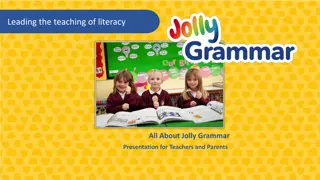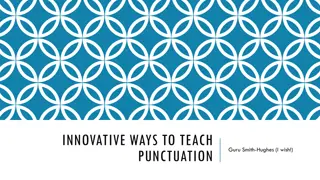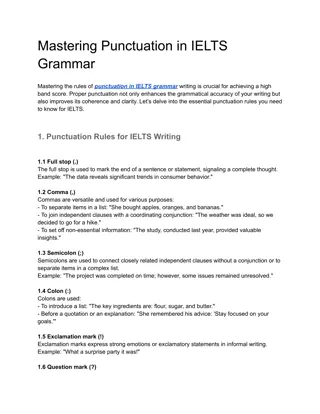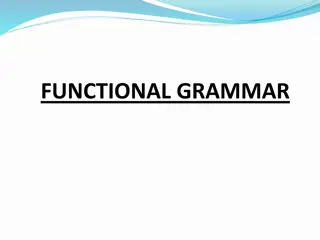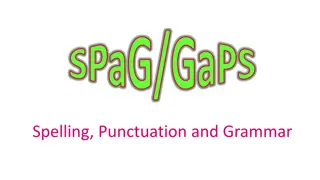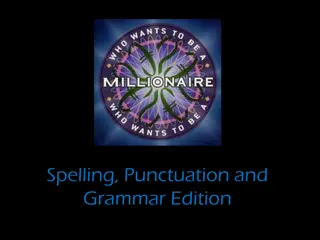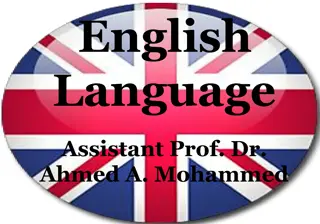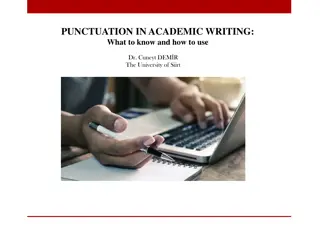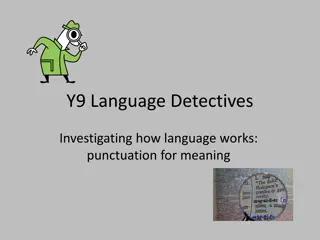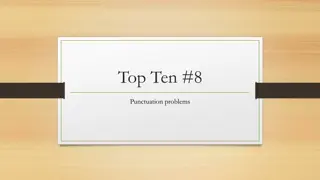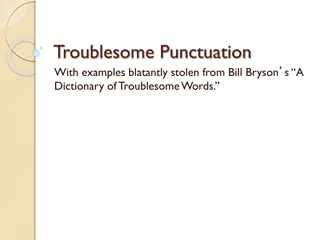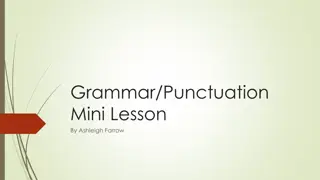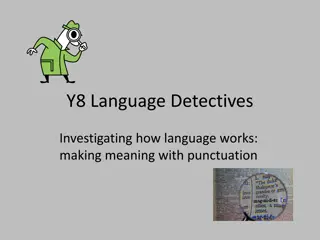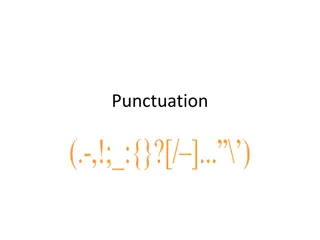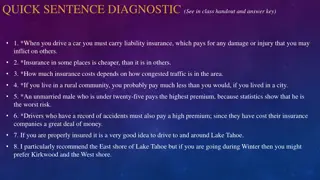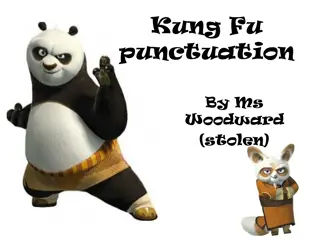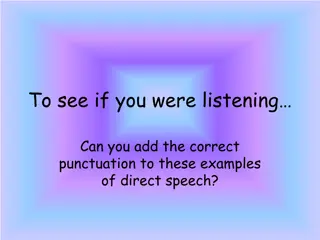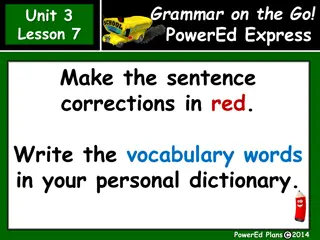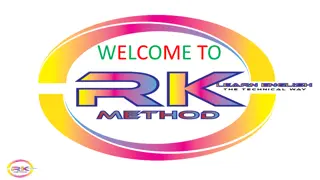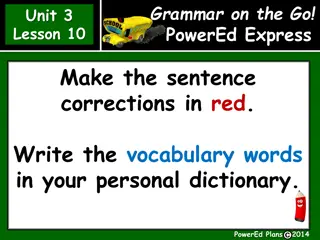Mastering Punctuation: A Comprehensive Guide to Grammar Essentials
This module delves into essential aspects of grammar, focusing on punctuation marks, including commas, periods, question marks, exclamation points, hyphens, and dashes. Learn how to correctly use these elements to enhance your writing and effectively convey your message. Explore the rules governing punctuation use and refine your skills in identifying and applying them in your writing.
Download Presentation

Please find below an Image/Link to download the presentation.
The content on the website is provided AS IS for your information and personal use only. It may not be sold, licensed, or shared on other websites without obtaining consent from the author. Download presentation by click this link. If you encounter any issues during the download, it is possible that the publisher has removed the file from their server.
E N D
Presentation Transcript
English Composition I & Co-Req Module 5: Grammar Essentials
Module Learning Outcomes Analyze the use of punctuation marks Analyze the use of apostrophes Analyze the use of commas Examine the use of semicolons and colons Critique passages, revising for run-on sentences and fragments
Learning Outcomes Demonstrate the standard uses of commas as separators Describe when to use periods, question marks, and exclamation points Identify when to use hyphens and dashes Correctly use parentheses Correctly use brackets Correctly use ellipses
End Punctuation Periods Periods indicate a neutral sentence, and as such are by far the most common ending punctuation mark. Question Marks Comes at the end of a question. Indirect Questions Indirect questions do not have question marks at their ends. Exclamation Points Used after an interjection or exclamation to indicate strong feelings or high volume.
Hyphens Fundamentally, the hyphen is a joiner. It can join several different types of things: two nouns to make one complete word (kilogram-meter) an adjective and a noun to make a compound word (accident-prone) two words that, when linked, describe a noun (agreed-upon sum) a prefix with a noun (un-American) double numbers (twenty-four) numbers and units describing a noun (1000-foot face; a 10-meter difference) prefixes and suffixes to words, in particular when the writer wants to avoid doubling a vowel or tripling a consonant (anti-inflammatory; shell-like) multiple adjectives with the same noun (blue- and yellow-green beads; four- and five- year-olds) A rule of thumb for the hyphen is that the resulting word must act as one unit; therefore, the hyphen creates a new word that has a single meaning.
Dashes The dash functions almost as a colon does in that it adds to the preceding material, but with extra emphasis. Like a caesura (a timely pause) in music, a dash indicates a strong pause, then gives emphasis to material following the pause. In effect, a dash allows you to redefine what was just written, making it more explicit. You can also use a pair of dashes in place of parentheses, to frame an interruptive or parenthetical-type comment that you do not want to de-emphasize.
Parentheses, Brackets, and Ellipses Parentheses Parentheses are used to set off information in a sentence that is important but not really a part of the main message. Brackets Brackets are a fairly uncommon punctuation mark. Their main use is in quotations: they can be used to clarify quotes Ellipses and Quotes EXAMPLE
When to Use Apostrophes With possessives, the apostrophe is used in combination with an s to indicate that a word literally or conceptually possesses what follows it. Plural Possessives Making plural words possessive can be confusing at times because we so often add an s to a noun to make it plural. Contractions A contraction is a shortened phrase. He will becomes he ll, are not becomes aren t, would have becomes would ve, and it is becomes it s. In all of these cases, the apostrophe stands in for the missing letters. Acronyms and Numbers
Quotation Marks You may not find yourself needing to use dialog very often in academic writing, but you may be asked to write narrative essays in some classes, which often contain dialog. You also will need to use quotation marks when you are quoting others words, which will happen in almost every genre of academic writing. When you use dialog, it s important to use quotation marks to set apart the speech from the rest of your text. Otherwise, separating the dialog from the rest of the writing can be very confusing for readers. When to use quotation marks? You should use quotation marks any time you use words directly from another source. Sometimes, students think putting a citation or reference at the end covers it, but you must use quotation marks to indicate borrowed words.
Quotation Marks (continued) There are four typical ways quotation marks are used. 1. The first is pretty self-explanatory: you use quotation marks when you re making a direct quote. 2. calling attention to a word. 3. To highlight the title of relatively short creative work or a part of a larger body of work, such as a newspaper article, poem, or chapter. Larger bodies of work, such as books, magazines, or newspapers are usually italicized. 4. Scare quotes: quotation marks that a writer places around a word or phrase to signal that they are using it in a non-standard, ironic, or otherwise special sense. This is the most misused type of quotation marks. People often think that quotation marks mean emphasis.
Learning Outcomes: Commas Demonstrate the standard uses of commas as separators Demonstrate the standard uses of commas with conjunctions and in lists Recognize the standard uses of commas
Commas as Separators Transition Words add new viewpoints to your material; commas before and after transition words help to separate them from the sentence ideas they are describing. Descriptive Phrases need to be separated from the things that they describe. Adjacent Items separated so that the reader can consider each item individually.
Conjunctions and Lists Coordinating conjunctions are words that join two words or phrases of equal importance. When these conjunctions join two words or phrases, no comma is necessary. The mnemonic FANBOYS helps us remember the seven most common: for and nor but or yet So When these conjunctions are used to join two complete ideas, a comma is required
Learning Outcomes Demonstrate the standard uses of semicolons Demonstrate the standard uses of colons
Semicolons: The Connectors Connecting Two Independent Clauses First, a semicolon can connect two complete ideas (a complete idea is an independent clause, which has a subject and a verb and can stand on its own as a sentence) that are related to each other and/or equal.
Colons: The Signposts The colon is like a sign on the highway, announcing that something important is coming. It acts as an arrow pointing forward, telling you to read on for important information. A common analogy used to explain the colon is that it acts as a flare in the road, signaling that something meaningful lies ahead. Use the colon when you wish to provide emphasis. Use the colon to introduce material that explains or summarizes what has preceded it. Use the colon to present a list or series, particularly when there is a lot of similar material to join or when the items in the list include commas.
Learning Outcomes: Complete Sentences Recognize sentence fragments Revise sentence fragments Recognize run-on sentences Revise for run-on sentences
Class Activity: Help On Your Campus What do you do if you need help with your writing? Do you know where your campus writing center is located? What if you need help and you re an online student? These are some common questions you might have as you practice being a writer in college. With a small group, locate campus resources on your school s website and make a list of URLs.
Sentence Fragments Fragments are simply grammatically incomplete sentences they are phrases and dependent clauses. These are grammatical structures that cannot stand on their own: they need to be connected to an independent clause to work in writing. So how can we tell the difference between a sentence and a sentence fragment? And how can we fix fragments when they already exist? A sentence fragment is simply a sentence that is missing one of its crucial elements: a subject, a verb, or a complete thought. One of the reasons we write in fragments is because we often speak that way.
Run-on Sentences Run-on sentences occur when two or more independent clauses are improperly joined. Often, in a run-on sentence, the independent clauses are simply joined without any punctuation or a coordinating conjunction. Another type of run-on that you ve probably heard of is the comma splice, in which two independent clauses are joined by a comma without a coordinating conjunction (and, or, but, etc.). Common Causes of Run-on Sentences We often write run-on sentences because we sense that the sentences involved are closely related, and dividing them with a period just doesn t seem right.
Quick Review Now that you have learned to recognize and resolve readability errors, develop a strategy for incorporating these skills into your writing process. Below are some guidelines for doing so: Revise for readability in the later stages of your writing process. In the early stages of writing, focus on your ideas. Leave time between drafting and revising for readability. Readability errors become more evident after you have stepped away from a project for a while and return to it later. Make proofreading/editing a vital part of your writing process.




